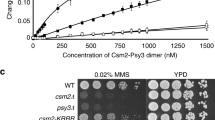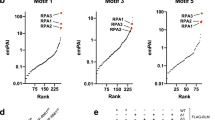Abstract
Homologous recombination (HR) has been extensively studied in response to DNA double-strand breaks (DSBs). In contrast, much less is known about how HR deals with DNA lesions other than DSBs (e.g., at single-stranded DNA) and replication forks, despite the fact that these DNA structures are associated with most spontaneous recombination events. A major handicap for studying the role of HR at non-DSB DNA lesions and replication forks is the difficulty of discriminating whether a recombination protein is associated with the non-DSB lesion per se or rather with a DSB generated during their processing. Here, we describe a method to follow the in vivo binding of recombination proteins to non-DSB DNA lesions and replication forks. This approach is based on the cleavage and subsequent electrophoretic analysis of the target DNA by the recombination protein fused to the micrococcal nuclease.
Access this chapter
Tax calculation will be finalised at checkout
Purchases are for personal use only
Similar content being viewed by others
References
Sugawara N, Wang X, Haber JE (2003) In Vivo Roles of Rad52, Rad54, and Rad55 Proteins in Rad51-Mediated Recombination. Mol Cell 12:209–219. https://doi.org/10.1016/S1097-2765(03)00269-7
Wolner B, van Komen S, Sung P, Peterson CL (2003) Recruitment of the Recombinational Repair Machinery to a DNA Double-Strand Break in Yeast. Mol Cell 12:221–232. https://doi.org/10.1016/S1097-2765(03)00242-9
Lisby M, Barlow JH, Burgess RC, Rothstein R (2004) Choreography of the DNA Damage Response. Cell 118:699–713. https://doi.org/10.1016/j.cell.2004.08.015
Heyer W-D, Ehmsen KT, Liu J (2010) Regulation of homologous recombination in eukaryotes. Annu Rev Genet 44:113–139. https://doi.org/10.1146/annurev-genet-051710-150955
Fabre F, Chan A, Heyer W-D, Gangloff S (2002) Alternate pathways involving Sgs1/Top3, Mus81/ Mms4, and Srs2 prevent formation of toxic recombination intermediates from single-stranded gaps created by DNA replication. Proc Natl Acad Sci U S A 99:16887–16892. https://doi.org/10.1073/pnas.252652399
Lettier G, Feng Q, de Mayolo AA et al (2006) The Role of DNA Double-Strand Breaks in Spontaneous Homologous Recombination in S. cerevisiae. PLoS Genet 2:e194. https://doi.org/10.1371/journal.pgen.0020194.st001
Prado F (2018) Homologous Recombination: To Fork and Beyond. Genes (Basel) 9:603. https://doi.org/10.3390/genes9120603
González-Prieto R, Muñoz-Cabello AM, Cabello-Lobato MJ, Prado F (2013) Rad51 replication fork recruitment is required for DNA damage tolerance. EMBO J 32:1307–1321. https://doi.org/10.1038/emboj.2013.73
Litwin I, Bakowski T, Szakal B et al (2018, 2018) Error-free DNA damage tolerance pathway is facilitated by the Irc5 translocase through cohesin. EMBO J:e98732-18. https://doi.org/10.15252/embj.201798732
Hung S-H, Wong RP, Ulrich HD, Kao C-F (2017) Monoubiquitylation of histone H2B contributes to the bypass of DNA damage during and after DNA replication. Proc Natl Acad Sci U S A 114:E2205–E2214. https://doi.org/10.1073/pnas.1612633114
Schmid M, Durussel T, Laemmli UK (2004) ChIC and ChEC. Mol Cell 16:147–157. https://doi.org/10.1016/j.molcel.2004.09.007
Friedman KL, Brewer BJ (1995) Analysis of replication intermediates by two-dimensional agarose gel electrophoresis. Methods Enzymol 262:613–627
Clemente-Ruiz M, Prado F (2009) Chromatin assembly controls replication fork stability. EMBO Rep 10:790–796. https://doi.org/10.1038/embor.2009.67
Naumov GI, Naumova ES, Lantto RA et al (1992) Genetic homology between Saccharomyces cerevisiae and its sibling species S. paradoxus and S. bayanus: electrophoretic karyotypes. Yeast 8:599–612. https://doi.org/10.1002/yea.320080804
Acknowledgments
This work was supported by grants BFU2012-38171 and BFU2015-63698-P from the Spanish government.
Author information
Authors and Affiliations
Corresponding author
Editor information
Editors and Affiliations
Rights and permissions
Copyright information
© 2021 Springer Science+Business Media, LLC, part of Springer Nature
About this protocol
Cite this protocol
González-Prieto, R., Cabello-Lobato, M.J., Prado, F. (2021). In Vivo Binding of Recombination Proteins to Non-DSB DNA Lesions and to Replication Forks. In: Aguilera, A., Carreira, A. (eds) Homologous Recombination. Methods in Molecular Biology, vol 2153. Humana, New York, NY. https://doi.org/10.1007/978-1-0716-0644-5_31
Download citation
DOI: https://doi.org/10.1007/978-1-0716-0644-5_31
Published:
Publisher Name: Humana, New York, NY
Print ISBN: 978-1-0716-0643-8
Online ISBN: 978-1-0716-0644-5
eBook Packages: Springer Protocols




